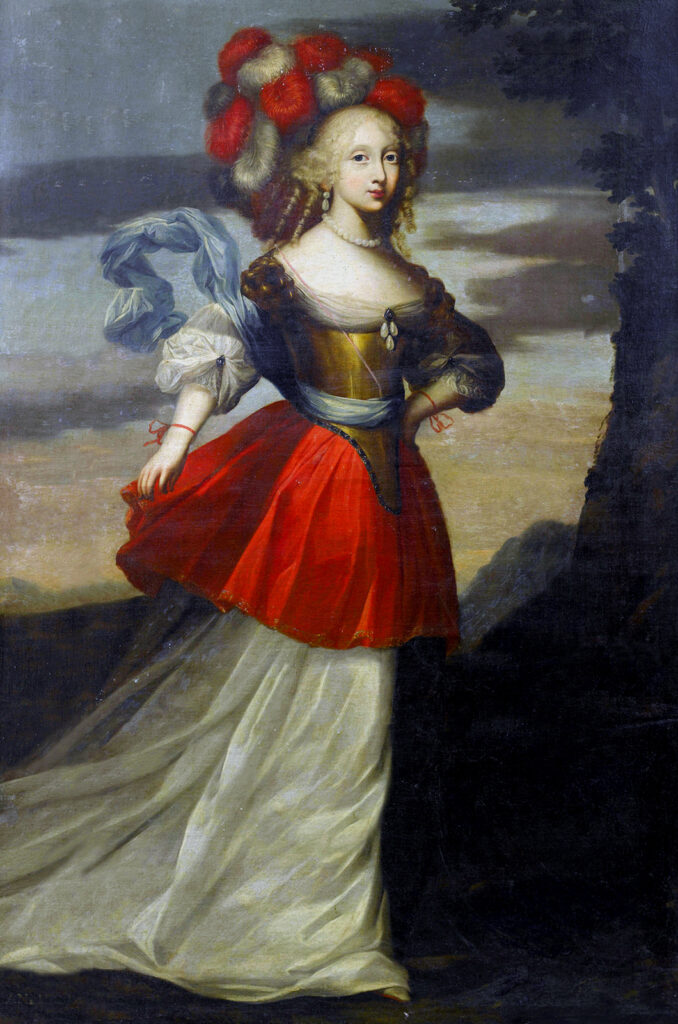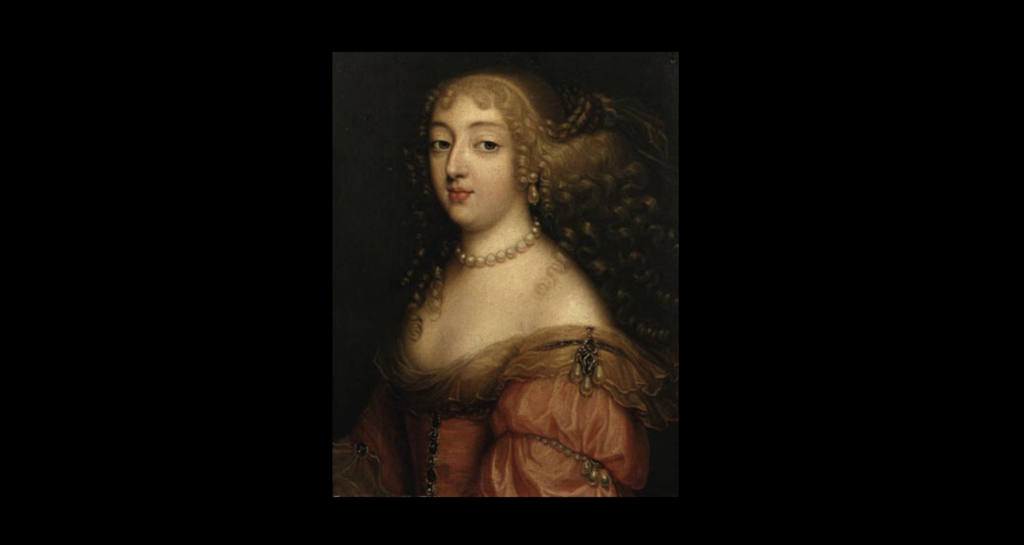The Mancini sisters are famous for their connections to the French court, thanks to the work of their uncle, Cardinal Jules Mazarin.
This is the first post in the series about the seven Mazarinettes. This post will explore the brief life of Laura Mancini, Duchess of Mercœur, but first, we must learn how the women came into the French court.
Cardinal Mazarin’s Power
Cardinal Jules Mazarin, who served as the chief minister to Kings Louis XIII and XIV, was an influential figure in seventeenth-century France. He was chief minister from 1642 until his death in 1661. Originally hailing from Italy, he relocated to France years before, and his two sisters followed him there. After having amassed so much power, he sought to consolidate it and create a legacy for himself. He possessed no children because he was a Roman Catholic clergyman of high rank. So, he turned to his two sisters, Laura Margharita, wife of Count Girolamo Martinozzi, and Girolama, wife of Baron Lorenzo Mancini.
Together, the minor noblewomen had seven daughters renowned for their beauty. Mazarin hoped that by introducing his seven nieces to the French Royal Court, they would make advantageous marriages, and he could surround himself with those he trusted. After all, a man with such power had many enemies. Laura Martinozzi’s daughters were: Anne Marie and Laura, while Girolama Mancini’s daughters were: Laura, Olympia, Anne Marie, Hortense, and Marie Anne.

The Mazarinettes in France
The widowed Anne of Austria, Queen Regent of France, was receptive to Mazarin bringing his nieces to court. In fact, she allowed the younger Mazarinettes (“little Mazarins”) to be educated alongside Louis XIV and his younger brother, Monsieur Philippe, Duke of Anjou.
From the moment they arrived at court, these young women caused quite a stir. The standard of beauty in France was pale skin and a sizeable figure, while the Mazarinettes possessed willowy figures and a darker skin tone. The Mazarinades, a political pamphlet, poked fun at these young women, referring to them as “dirt princesses” and “stinking snakes.”
The truth is that they did not bring a large dowry with them. According to French historian Jacques Hillairet, they weren’t very wealthy at all.
As they were presented at court, Marshal Nicolas de Neutville de Villeroy famously whispered to his uncle, Gaston, Duke of Orléans: “Voilà des petites demoiselles qui présentement ne sont point riches, mais qui bientôt auront de beaux châteaux, de bonnes rentes, de belles pierreries, de bonne vaisselle d’argent, et peut-être de grandes dignités” or “Here are young ladies who just at present are not rich at all, but who soon shall have beautiful castles, good incomes, precious stones, substantial silver plate, and maybe great dignities.”
Little did he realise just how prophetic his words were because the Mazarinettes all made advantageous marriages.

Laura Mancini —The First Mazarinette
Like the rest of the Mazarinettes, Laura was born in Italy; she was born on 6 May 1636. Her parents, Baron Lorenzo Mancini and his wife, Girolama, belonged to the minor aristocracy. Together the couple produced ten children.
Five of their daughters would belong to the infamous Mazarinettes. The eldest child born to this union was Laura Vittoria. She was named for her paternal grandmother, Vittoria Capocci. History does not reveal much about the lives of the Mancinis in Italy.
According to the author, H. Noel Williams, Laura arrived at the Palais Royal on 11 September 1647 and was described as “a pleasing brunette, with a handsome face, about twelve or thirteen years of age.”
Because Queen Anne favoured Cardinal Mazarin and his nieces, she allowed Laura, her siblings, and her cousins to be playmates of young Louis XIV and his brother, Monsieur.
Marriage
When she was of age to marry, several suitors were proposed for her. One such suitor was Louis-Charles de Nogaret de Foix, Duke of Candale.
In his own right, the Duke of Candale was a handsome man, but he died before the marriage could take place. Laura eventually married a Prince of the Blood, Louis, Duke of Mercoeur, on 4 February 1651. Thereafter she would be referred to as Her Serene Highness, especially since she was now a Princess of the Blood (Princesse du sang).
He was the son of César, Duke of Vendôme (the illegitimate son of King Henry IV of France) and his wife, Françoise of Lorraine. While César was born of an illegitimate union between Henry IV and Gabrielle d’Estrées, he was legitimised on 4 February 1595.
By all accounts, the Duke of Mercoeur was an honourable and pious man. He fought in the Thirty Years’ War and was injured at the Siege of Arras. Not only was he the Duke of Mercoeur, but he was the Viceroy of Catalonia as well. History tells us that he was attracted to Laura Mancini and favoured this marriage.
Cardinal Mazarin, lurking in the background pulling the strings, promised the Duke of Vendôme a sizable dowry of 600,000 livres if he would endorse this marriage.
Meanwhile, in France, Cardinal Mazarin was facing a great deal of opposition. According to Jacques de Bourbon-Busset, Mazarin willingly entered exile while the Fronde Civil Wars took place in France. He lived for a while at Brühl as a guest of the Archbishop-Elector of Cologne, Maximilian Henry of Bavaria. While he was in exile, Mazarin privately blessed the marriage of Laura and Mercoeur at a chapel in the castle where he was staying. She elected to stay with her uncle at Brühl while Mercoeur returned to France, where conflict was building.
Mercoeur was called before Louis, Prince of Condé and the Parliament. They demanded answers about his marriage and relationship with the controversial Mazarin family. According to Jacques Hillairet, they released the declaration that Laura Mancini wasn’t to enter the kingdom or to remain within its borders. Mercoeur refused to have his marriage annulled as the marriage was legitimate. As a result, Laura remained the Duchess of Mercoeur, and Cardinal Mazarin would win his first victory against Condé.

On 3 February 1653, Mazarin called upon the Duke of Mercoeur and Duke of Modena to help restore order in Provence after the Prince of Condé encouraged a revolt, stated Jacques Hillairet. While her husband was away fighting the Spanish, Laura returned to France and lived a pious life. She was still much beloved by Queen Anne. Additionally, she would visit the Castle of Anet, where she would spend time with her mother-in-law, the Duchess of Vendôme.
At this time, Laura was a favourite of King Louis XIV. In an anecdote shared by contemporary memoirist Madame Françoise Bertaut de Motteville, Louis was accustomed to and enjoyed opening the ball with the Mazarinettes. When a ball was about to begin, he automatically called for Laura to open the ball alongside him. Queen Anne disapproved of this etiquette faux pas and called for her niece, Princess Henrietta of England, to open the ball with him instead. The Queen stated an ultimatum that he would open the ball with Princess Henrietta or he wouldn’t dance at all. The King, resolute in his ways, rejected the idea as he did not want to dance with a little girl, reported Jacques Hillairet. Nevertheless, he did as his mother commanded him.
Children and Her Death
The Duke and Duchess Mercoeur had three sons: Louis Joseph, Philippe, and Jules César. The two eldest sons lived to adulthood and had no children. The third son died at the age of three. Laura suffered great sorrow as right before her third son was born, she lost her mother, who died on 29 December 1656 at the Louvre Palace. She was beside herself with sadness.
The birth of her son Jules César put her in great danger. According to Madame de Motteville, Cardinal Mazarin was not worried at first, but eventually, he rushed to her side and “found that she was dying, and that, unable to speak, she could only smile.”
The little boy was born on 27 January 1657 and named after Cardinal Mazarin. Mazarin and the Duke of Mercoeur were heartbroken by this turn of events. Then, on 8 February 1657, Laura died. According to Jacques Hillairet, the Archbishop of Aix wrote in his memoirs of this sorrowful scene: “The cardinal came to give her the sacraments himself. She seemed so beautiful in this sad state that one could not imagine that she had died.”
Laura was 20-years-old; her body was interred in Paris.

By Daniel Dumonstier – https://www.photo.rmn.fr/cf/htm/CSearchZ.aspx?E=2K1KTS2KXK2W7&SubE=2C6NU07MF3SJ, Public Domain
The person who took her death the hardest was the Duke of Mercoeur. Not long after her death, he put his three sons in the care of Laura’s sister, Anne-Marie Mancini, Duchess of Bouillon. He decided to enter a Capuchin convent. Ten years after the death of his wife, he was made a Cardinal. With his father, the Duke of Vendôme, passing away in 1665, the title passed immediately to him. Instead of being a duke, he was known thereafter as the Cardinal of Vendôme.

